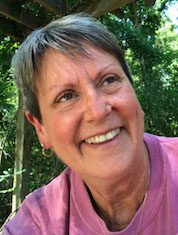On Sunday night of this past Labor Day weekend, I laid on my back beside a fire pit looking at a murky night sky.

Sparks from the burning logs rose into the sky on a current of hot air and expired along with the waning hours of summer. No stars were visible. A layer of clouds separated the heavens from the earth, backlit by the presence of a mostly full moon. Crickets blared out in a cacophony of scratchy sound, and the memories of past campfires flooded my thoughts. The smell of the fire floated inside of the smoke. Dry wood cracked and popped as the flames separated the timber’s sinews. For a moment, time passed unencumbered by responsibility, or obligations, or deadlines.
My husband and I spent the holiday weekend in Clarksville, a small town in north Georgia, not too far from Helen, an artificial Alpine village built for tourists on a quest for a southern Oktoberfest. The trip marked the occasion of a belated celebration of our twenty-third wedding anniversary. We rented a tiny cabin in the foothills of the Blue Ridge Mountains. The trees surrounding our “home away from home” were still dressed in green, anxious for a change in temperatures to sport the orange and yellow regalia of autumn.
During my weekend stay, I had the opportunity to pass some time in leisurely reading. I read my first Flannery O’Connor story sitting on a metal bench beside Amy’s Creek, a narrow stream that gurgled at the base of the converging hills, and played host to a school of small minnows. Because trees surrounded me, I choose a story from the O’Connor collection entitled “A View of the Woods.” The tale was a bit gory, centering on a nine-year-old girl, her grandfather, and their eventual, and mutual, demise. A third character, prominent among the peripheral cast in the short story, was the woodlands – tall southern pines whose bare trunks gave the appearance of lanky sentries standing guard across the street from the family’s home. The woods lined the edge of the road and the shores of the man-made lake that now bordered the backyard of their farmhouse.
What struck me about the story (along with the spot-on southern dialogue and the keen sense of place O’Connor delivers in her writing) was the repeating theme of geographical demarcations I had been encountering throughout the weekend. Tallulah Gorge, with her north and south rims, were a short drive from our cabin. The trail we hiked in Moccasin Creek State Park with our dog Toby had markers describing the “edges” of the forest that opened to clearings where deer and small game fed at dawn and dusk. The state lines of Georgia, South Carolina, North Carolina, and Tennessee collided around us and were drawn with blue dashes on an old map of Georgia we pulled from the glove compartment to situate ourselves.
A few days before, I crossed the equator for the first time on a business trip to South America. I had never really thought about the southern and northern hemispheres. I rarely put the Earth into the context of longitude and latitude, and I am beginning to understand the world a bit better because of my travels – why it is winter in the Southern Hemisphere when it is summer on my side – in the Northern Hemisphere. It did not seem like the phase of the moon changed from one continent to the other, and I am guessing that is because I moved east by only one time zone.
Turning on my side to look into the heart of fire from the safety of its sidelines, it dawned on me that living on the edges of life is too confining and limiting. The edges, and rims, and manmade lines drawn to measure the planet, are metaphors for boundaries I often meet and need to cross. What holds me back? The limited resource of time and an aversion to risk probably cause me to make choices that stifle my advancement across the perceived boundaries of work, play, and family. Even my struggle with faith keeps me on life’s cliffs and away from the joy of diving into new opportunities.
On July 18, 1970, a 65-year-old Karl Wallenda walked across Tallulah Gorge on a high wire. Not only did he successfully complete the quarter mile “stroll,” he executed two headstands over the 600-foot gorge to the amazement of 30,000 on-lookers. The towers that secured the tightrope now rest sideways on the north and south rims of the canyon, a testament to the daring and skill of a man willing to cross lines to accomplish great feats.
I do not want to live on the periphery of life. I know that diving into the challenges of my job, and living through the wins and losses of family life, are at the center of a rich and fulfilling existence. As I lay at the edge of this season’s last summertime campfire, it was evident that the heart of the fire, where the flames burned a hot blue-white, was where I wanted to exist in my life. Not on the rim or on the sidelines of the real action. I want the courage of a tightrope walker, the exhilaration felt by a daredevil, and the heat of a loving heart willing to risk everything for family, friends and faith.





